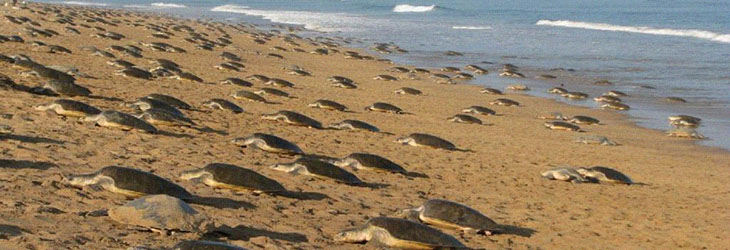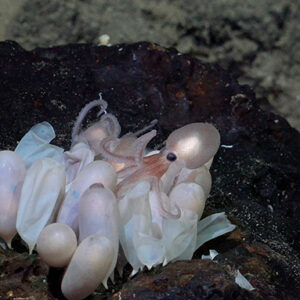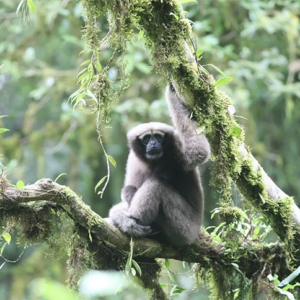
A video taken on a beautiful Indian beach shows the “magical moment” when around twenty million rare baby sea turtles make their way out to sea for the first time. These Olive Ridley sea turtle hatchlings were caught on camera as they were crawling along the coastal beach of the eastern state of Odisha.
The video was taken by Indian Forest Officer, Susanta Nanda, who eventually shared it on his Twitter account. He wrote, “A sight that casts magical spell year after year. Nearly 2 crore plus [20 million] olive ridley hatchlings have emerged & made their way to sea from half about 4 lakh [400,000] nesting at Nasi-2 islands, Gahirmatha rookery Odisha. The spectacle continues. Early morning video.”
https://twitter.com/susantananda3/status/1258624380935888897?ref_src=twsrc%5Etfw%7Ctwcamp%5Etweetembed%7Ctwterm%5E1258624380935888897%7Ctwgr%5E&ref_url=https%3A%2F%2Fthemindunleashed.com%2F2020%2F05%2Fstunning-video-shows-when-twenty-million-rare-baby-turtles-crawl-to-sea-for-first-time.html
What seemed to make this recorded event more special was that according to the website Mongabay, this was the first time in nearly seven years that the turtles came out to nest during the daytime. According to the foundation Oceana, who’s tagline is ‘Protecting the World’s Oceans,’ these particular type of turtles are also considered the smallest sea turtle species on the planet.
Although the Olive Ridley population is one of the most plentiful all over the world, like other types of sea turtles, they are still vulnerable when it comes to their survival rates. Olive Ridley sea turtles specifically are considered endangered in Mexico due to “human-related activity,” as well as threatened in a number of other locations for a variety of reasons.
But one main reason is that these turtles can only nest in particular locations, which include Costa Rica, Mexico, and Nicaragua, aside from India. In addition to that, some nesting difficulty also comes from particular locations ending up disturbed due to human interventions, other animal species preying on them, or large scale global issues like rising sea levels or global warming, which has led to colossal fallouts when it comes to the entire species population growth.
According to conservationist group, World Wildlife Fund, “Sea turtles are the living representatives of a group of reptiles that has existed on Earth and travelled our seas for the last 100 million years. They are a fundamental link in marine ecosystems and help maintain the health of coral reefs and sea grass beds.”
Back in March, a batch of around 475,000 Olive Ridley sea turtles were found to have come ashore to nest and lay their eggs on the 3.75-mile Rushikulya beach located in India as well. According to the local district forest officer, Amlan Nayak, there were over 250,000 mother turtles that happened to go nesting during the daylight hours in a single week alone.
District Forest Officer Nayak shared with Mongabay-India, “The last time we saw day time nesting of the olive ridleys along this site was in 2013. Usually, they come on to the beach for nesting only during the night. This March was special for us as we saw the species visiting the site at night and even during the day, in equally good numbers.”
Apparently, local authorities also shared that at that time, there was an estimated 60 million eggs that would probably be laid within the year in total. This mass hatching tends to bring loads of tourists to their shores that time of year, hoping to be a witness to this miracle of the animal kingdom. Of course, this also means that the local authorities struggle to keep the tourists back as well, making sure that they don’t endanger this awesome occurrence.
Of course this year was very different though, what with COVID-19 changing the course of travel due to the ongoing lockdowns. With the absence of crowds, the allotted 25 forest guards were able to truly focus on the safety of the turtles as they hatched, rather than keeping spectators back. The problem with the lack of humans though was the presence of crows and jackals that were now free to feast upon the powerless turtles.
Yet despite that, President of Orissa Environment Society, S.N. Patro, claims that there was no major impact of the lockdown on the Olive Ridley sea turtles nesting patterns. Patro explained, “What the lockdown can do is that it can reduce the casualties of the sea turtles or the damages their eggs undergo in normal days. However, in the absence of human movements, pest attacks from other animals can increase as well.”
Mass nesting of Olive Ridley turtles in Odisha coast while nation is at 21 day lockdown. #Nature #21daylockdown #pandemia pic.twitter.com/z7ihzOYu0E
— Harikrishnan S (@_harikrishnan_s) March 26, 2020
He added, “They [turtles] are quite confident. The village communities in Rushikulya have known of arribadas [the Spanish word for ‘arrival’ that refers to the mass nesting events] of olive ridley turtles since time immemorial.”
According to the Times of India, sadly, hundreds of these newly hatched baby turtles in Odisha died during their first crawl out to sea after being caught in a number of fishing nets that were strung along the coastline.
But thankfully, just around 1000 miles away at the Indian state of Goa on their southwestern coast, another thousand Olive Ridley hatchlings were caught on video coming out of their nests as well. The video was taken and shared by the local Chief Minister Pramod Sawant.
He shared, “Amazing wonders of nature! Olive Ridley turtle hatchling emerging out from the last nest at Morjim. Along with Morjim, Mandrem, Agonda, and Galgibagh are important beaches in Goa which attracts turtle for nesting.”
Amazing wonders of nature! Olive Ridley turtle hatchlings emerging out from the last nest at Morjim. Along with Morjim, Mandrem, Agonda and Galgibagh are important beaches in Goa which attracts turtle for nesting. pic.twitter.com/UjuoIC9hP4
— Dr. Pramod Sawant (@DrPramodPSawant) May 12, 2020
What are your thoughts? Please comment below and share this news!
True Activist / Report a typo


